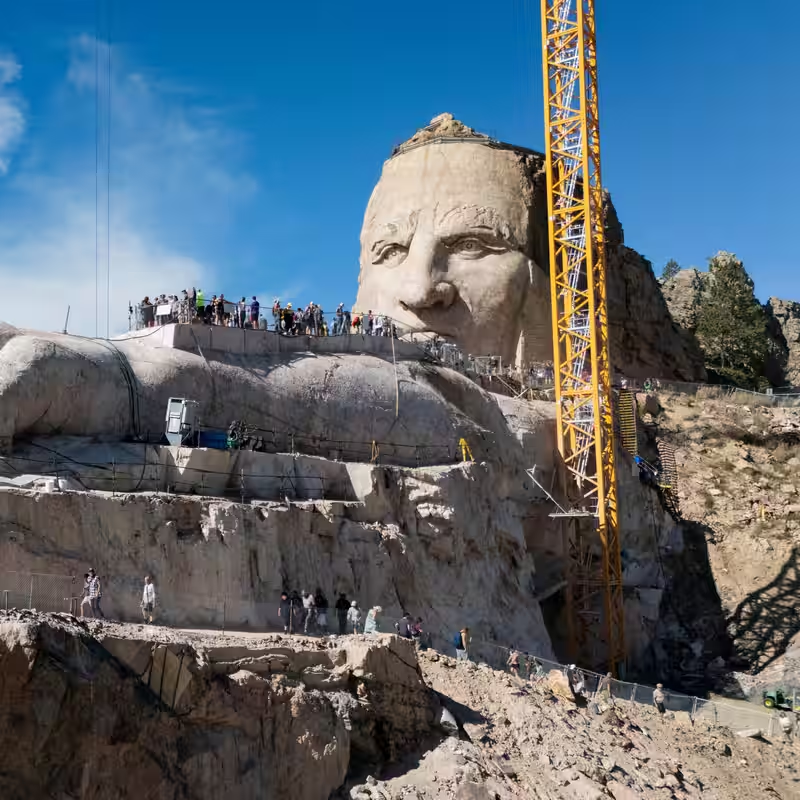On a crisp September morning in South Dakota’s Black Hills, more than 5,000 people gathered before dawn at the base of Thunderhead Mountain. They weren’t there for a music festival or a political rally—but for a rare chance to hike up to the face of Crazy Horse, the unfinished monument to the legendary Lakota war chief that has been under construction for 77 years.
This biannual event—held only twice a year—is one of the few times the public can walk right up to the colossal sculpture-in-progress. But as visitors gazed up at the 88-foot-tall face and the 29-foot index finger pointing toward the Pine Ridge Reservation, reactions ranged from awe to anguish. For many, the hike stirred deep patriotism. For others, it unearthed unresolved grief over America’s treatment of Native peoples.
What Is the Crazy Horse Memorial?
The Crazy Horse Memorial began in 1939 when Lakota elder Henry Standing Bear invited Boston sculptor Korczak Ziolkowski to carve a tribute “to show that the red man had great heroes, too”—a direct response to nearby Mount Rushmore, which features four U.S. presidents on sacred Lakota land.
Ziolkowski accepted and moved to South Dakota, dedicating his life to blasting and shaping the mountain. After his death in 1982, his wife and 10 children took over. Today, his grandchildren continue the work—slowly chiseling away at what will one day be the world’s largest sculpture: 563 feet high and 642 feet long.
A Monument of Contradictions
For some, like retired farmer Jeff Tuschen of South Dakota, the memorial is a symbol of progress. “You can really see they’re ramping up progress,” he said on his 12th visit.
But for many Native Americans, the project is fraught. “It breaks my heart a little that I don’t see more tribal people,” said Darrah Goggles, a member of the Blackfeet Nation. “It seems very touristy.”
Critics argue that carving into the Black Hills—a range considered sacred by the Lakota—amounts to desecration. Others question the allocation of resources: the memorial is privately funded through admissions and donations, raising concerns that millions could be better spent addressing poverty, housing, and healthcare on nearby reservations.
What Does Crazy Horse Look Like?
There’s another layer of uncertainty: no verified photograph of Crazy Horse exists. The face on the mountain is based on oral descriptions and educated guesses—a fact that adds to the debate over authenticity.
Visitors Share Mixed Emotions
Wendy Farmer, a retired Army veteran now living in South Dakota, brings every visitor to both Mount Rushmore and Crazy Horse. “I always say, ‘You gotta see both, because they’re both the United States of America,’” she explained.
But Oglala Lakota veteran Joseph Cross sees it differently. Standing near the sculpture, he reflected: “There are a lot of homeless Natives out there. I think what [Crazy Horse] would do is take all the energy and resources being put into this and apply it to the people.”
Recent Controversy Adds Tension
The hike came just days after Defense Secretary Pete Hegseth announced that Medals of Honor awarded to soldiers involved in the 1890 Wounded Knee Massacre—where over 300 Lakota men, women, and children were killed—would not be revoked. The decision reignited pain for many Native attendees.
“That was a massacre, a crime against humanity,” Cross said. “They should be awarding the Great Sioux men who protected those women and children.”
Crazy Horse vs. Mount Rushmore: Key Facts
| Feature | Crazy Horse Memorial | Mount Rushmore |
|---|---|---|
| Location | Thunderhead Mountain, Black Hills | Mount Rushmore, Black Hills |
| Started | 1948 | 1927 |
| Completed? | No (77 years and counting) | Yes (1941) |
| Funding | Private (admissions, donations) | Federal government |
| Height (planned) | 563 feet | 60 feet per face |
| Sacred Land? | Yes (to Lakota and other tribes) | Yes |
Why the Hike Matters
For many, the biannual hike isn’t just about sightseeing—it’s a pilgrimage. Tiffany Taylor, a cosmetologist from Minnesota whose father is Lakota, called it a “bucket list” moment. At the summit, she embraced her friend and whispered, “This is my first time hiking.”
Others, like Derek Thunder Hawk of the Oglala Lakota, run to the top to burn sage and pray. “A lot of people think we are wiped out,” he said. “When you see something like this, or someone like me, well, it’s a reminder… that we are not dead.”
The Road Ahead
With no completion date in sight and growing debate over its purpose, the Crazy Horse Memorial remains a powerful symbol—of resilience, of contradiction, and of a nation still wrestling with its past.




